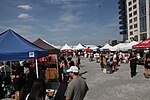Austin, Nichols and Company Warehouse

The Austin, Nichols and Company Warehouse, also known as 184 Kent Avenue and Austin Nichols House, is a historic warehouse building on the East River between North 3rd and North 4th Streets in Williamsburg, Brooklyn, New York City. The structure, measuring 179 by 440 feet (55 by 134 m), was built in the Egyptian Revival style; it is one of the city's few buildings in that style. The building was designed by architect Cass Gilbert and erected by general contractor Turner Construction with the help of structural engineer Gunvald Aus. The warehouse was built in 1914–1915 to a design by Gilbert, and was one of several commercial and industrial buildings along the East River waterfront. The land was originally owned by the Havemeyer family, and leased to Austin, Nichols & Company, at one point the world's largest grocery wholesaler. Austin, Nichols & Company occupied 184 Kent Avenue from 1915 until the mid-1950s, after which the structure was occupied by several manufacturers. Starting in the 2000s, the building was used as a residential structure, and a 2010s renovation added residential condominiums. The warehouse was designated a New York City Landmark in 2005, though the designation was controversial and was overturned by the New York City Council in 2006. The building was listed on the National Register of Historic Places in 2007, a less restrictive designation that allowed for the warehouse's redevelopment into condominiums.
Excerpt from the Wikipedia article Austin, Nichols and Company Warehouse (License: CC BY-SA 3.0, Authors, Images).Austin, Nichols and Company Warehouse
North 4th Street, New York Brooklyn
Geographical coordinates (GPS) Address External links Nearby Places Show on map
Geographical coordinates (GPS)
| Latitude | Longitude |
|---|---|
| N 40.718611111111 ° | E -73.964166666667 ° |
Address
Austin Nichols House
North 4th Street
11249 New York, Brooklyn
New York, United States
Open on Google Maps




